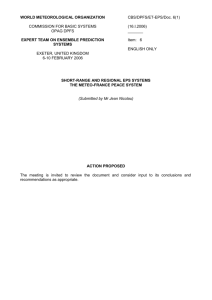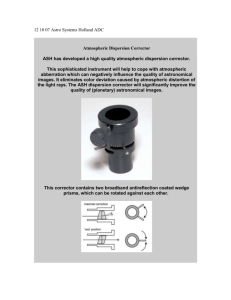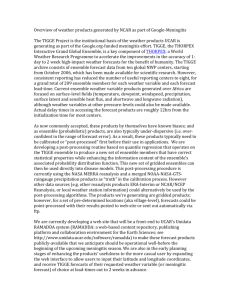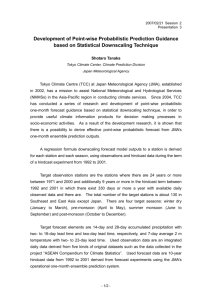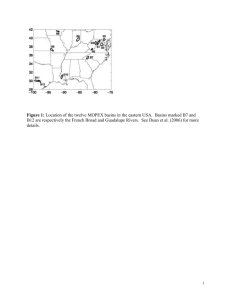WORLD METEOROLOGICAL ORGANIZATION
advertisement
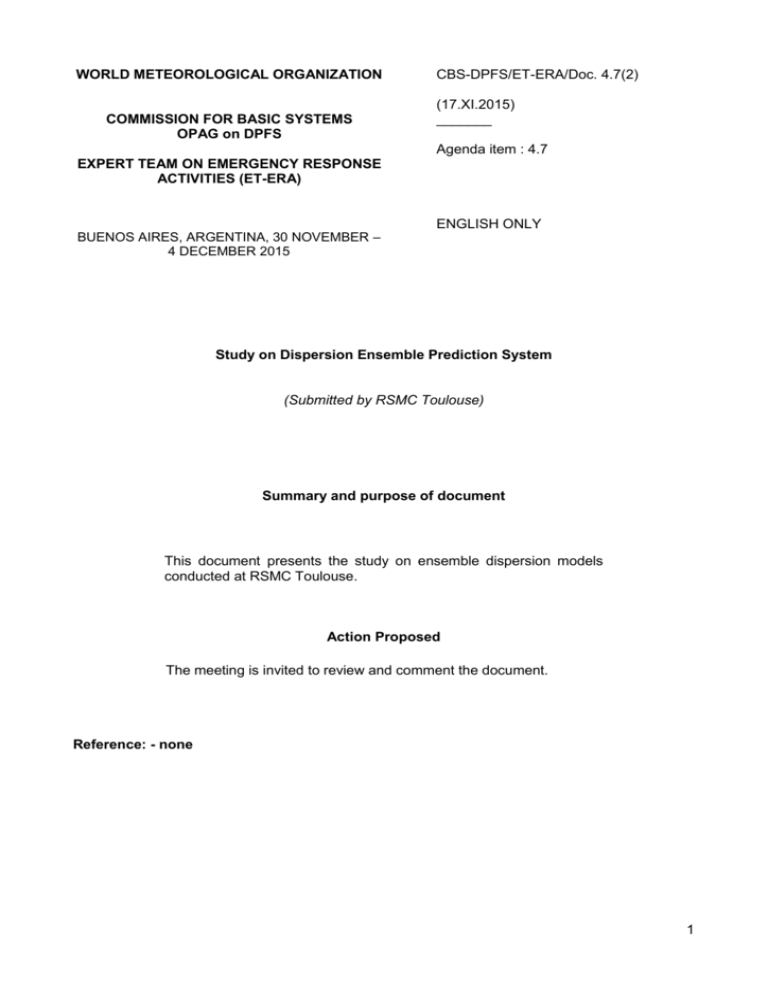
WORLD METEOROLOGICAL ORGANIZATION COMMISSION FOR BASIC SYSTEMS OPAG on DPFS CBS-DPFS/ET-ERA/Doc. 4.7(2) (17.XI.2015) _______ Agenda item : 4.7 EXPERT TEAM ON EMERGENCY RESPONSE ACTIVITIES (ET-ERA) BUENOS AIRES, ARGENTINA, 30 NOVEMBER – 4 DECEMBER 2015 ENGLISH ONLY Study on Dispersion Ensemble Prediction System (Submitted by RSMC Toulouse) Summary and purpose of document This document presents the study on ensemble dispersion models conducted at RSMC Toulouse. Action Proposed The meeting is invited to review and comment the document. Reference: - none 1 1. INTRODUCTION Ensemble techniques have been used in atmospheric modeling since the early 90’s years. The idea was to explicitly forecast uncertainties. Both NCEP and ECMWF have developed first ensemble prediction systems in 1992. At the time being roughly 10 centers are daily running global ensembles and a lot of LAM EPS have been developed by different NMSs. Ensemble Prediction Systems have proved that useful information on uncertainties can be predicted by this way under different forms : plumes, stamps, probability charts, EFI, EPSgrams, … Although there only a little part of these information is provided to the public, it enter now completely in the forecasters decision process. Ensembles techniques are also used in other domain such as marine forecasting (Waves or surgery forecast) or hydrology (Flow forecast). It is also already used in marine pollutant forecast. For instance, in case of oil pollution near the French coasts, Météo-France provides probabilities of pollution. This is particularly important for nuclear plants which are located on these estuaries (see picture) Example of probabilistic forecast from (PEARP/MOTHY) ensemble : pollution probability chart and probabilistic wind roses. This kind of forecast is build by coupling our marine pollution dispersion model (MOTHY) with our global ensemble prediction system (PEARP). As there is a lot of uncertainties it is then obvious that ensemble techniques could be also applied in this case of atmospheric pollution. A first study was conducted at RSMC Toulouse in order to evaluate the feasibility of a pollutant dispersion EPS. We present here the main conclusions of this study. 2 2. ANALYSIS The first thing to do is to identify the different sources of uncertainties. We can identify four of them, concerning: The atmospheric forcing The initial state The source term The dispersion model itself a. Atmospheric uncertainties A numerical model cannot forecast or describe a phenomenon smaller than the size of its temporal or spatial grids. The numerical schemes are more or less precise for this reason. Certain elements of low importance are ignored or simplified: spectrum of the droplets in the clouds, representation of the urbanisation, etc. Some mechanisms are approximate only through parameterizations. This is the case for example, the cases of the convection, precipitations, the radiation or the representation of complex mechanisms of under-grid. There are two aspects to be taken into account: atmospheric initial state uncertainties and meteorological forcing uncertainties. Both of them can be given by atmospheric EPS. As they are built to forecast the atmosphere pdf they are a relevant reference to give a good picture of the uncertainties on the different atmospheric fields used in the forcing. Initial state uncertainties are quite well catch by different techniques: singular vectors, “Breeding the Growing Modes (BGM)”, Ensemble Transform Kalman Filter, Ensemble data Assimilation,… In addition EPS fields are already available. Concerning the model itself uncertainties, it is well known that they are not comparable to the initial state ones. Nevertheless some techniques exist to mimic these uncertainties: using different physics schemes, tuning some parameters in the physics, using random coefficient weighting physics tendencies, stochastic schemes… Nevertheless EPS usually are composed of a lot of runs. As running dispersion model is costly, it is then necessary to select the most relevant members to force fewer dispersion model runs. For that some techniques such as clustering exist. These kinds of classification methods tried to gather close runs into cluster. Then only one cluster representative is kept. It is possible to choose the relevant parameter(s) on which the classification will be based. For these uncertainties, it is proposed to select some (10 for instance) representative members from the atmospheric global ensemble and to use them to force the dispersion model. b. Initial state uncertainties Generally speaking this aspect is very important in the uncertainties evaluation. In NWP model, Lorentz has shown the sensitivity of the numerical prediction to the initial state description (“butterfly effect”). Nevertheless it is not the same thing in accidental air pollution. Indeed,, except in the restart mode, dispersion model run from a “0” initial state, the only initial perturbation being described by the source term (next point). There won’t be any description of initial state uncertainty except the ones from the source term. We can yet note that initial state uncertainties could be relevant in case of air quality prediction. c. Source term uncertainties It is certainly one of the most important source of uncertainties. Most of the time, the quantity of rejected pollutant is unknown during the emergency period. That leads to the use at standard 3 emission rate and, because of the impossibility to bring information about the overtaking of critical thresholds, in a qualitative interpretation of the results. Beyond the absence of data on the total quantity of released pollutant, it is the variations of the flow and the end of the release (release kinetics) that are not known. Nevertheless a constant flow could be well adapted for limited duration (explosion for instance). Vertical distribution Vertical distribution of pollutant could have a great impact to the release. This distribution is represented in our models by a layer in which the pollutant has a uniform distribution. This layer is defined by its top and its bottom. Both are filled bye the forecaster, according to the information he gets on the release. A way simple way to perturb this vertical distribution of pollutant at the release point would consist in perturbing the layer top and bottom. Kinetics of the release The consideration of the uncertainty on the kinetics of the release faces to the difficulty to anticipate this kinetics and to estimate the amplitude of the disturbance to be brought to it. Splitting the release over different time periods would only complicate the process without expected positive results. It is also useless to work on the constant flow. The modification of the released quantity would be given by a proportional transformation of the results. We cannot thus take into account the uncertainty linked to the kinetics of the release. Pollutant description This last point will mainly concern the transport and the dispersal of volcanic ashes In case of volcanic ashes it is interesting to get a size distribution of the particles. This distribution is built from statistics. However, particles released during chemical or radiological accidents are too small so there is no sedimentation effect. Thus it is not worth using such distributions. d. Model dynamics and physics uncertainties The models of dispersion of pollutant can be close to NWP models as regards the uncertainty which is introduced with the wire of calculations. Temporal and spatial discretization, parameterizations and also representation of the source of pollutant are as many sources of error. The temporal evolution of the flow of emission can be very complex, as one saw at the time of reconstruction of the kinetics of rejections, at the time of accidents like Tchernobyl or more recently in the case of the factory of Lubrizol and is generally not known at the time of the emergency answer. During controlled explosions or rejections this kinetics could be accessible. We could certainly prospect on the leaching and the soil depository, but at the first step it seems difficult to do it properly, so we won’t take into account these uncertainties 4 3. VERIFICATION Until the advent of ensemble prediction systems, verification of forecasts from numerical weather prediction models involved simply matching the model forecast in space and time with the corresponding observation. With a single model run, there could usually be a one-to-one match between forecast and observation, on which numerous quantitative verification measures could be computed. An ensemble system (and more generally speaking, any probabilistic forecasting system) produces a distribution of forecast values for each point in time and space, but there is still only a single observation value. The challenge of ensemble verification is to devise a quantitative method to compare the distribution against specific observation values. There are 3 main aspects to take into account: Reliability (Correspondence of conditional mean observation and conditioning forecasts, averaged over all forecasts) Resolution (Difference between conditional mean observation and unconditional mean observation, averaged over all forecasts) Sharpness (Variability of forecasts as described by distribution forecasts) For all of these aspects, probabilistic scores are used (ROC curves, reliability diagrams, Rank Probability Score, Brier Score, …). The verification of pollutant dispersion model is difficult because of (1) lack of real cases (fortunately!) and (2) poor measurements of pollutant. It will even more difficult to validate probabilistic forecast which needs great samples. This would be a weakness in the process of building a Dispersion EPS. However it is very important to estimate wether the different perturbations are realistic. For that a subjective evaluation could be conducted in order to correctly tune these perturbations. It could be also possible to perhaps use volcanic eruption in order to evaluate the Dispersion EPS behavior. 4. PRODUCTS Different products could be provided in order to get information from the whole distribution: Spaghettis plots of trajectories Mean and spread maps of concentration Probabilities maps for the concentration to be up than different thresholds Quantile maps, (Q75, median) for the concentration Plumes of concentration density Strike probabilities (probabilities of density of trajectories, already used for cyclons) Relevant thresholds will have to be set. Examples of such products for atmosphere EPS are shown on the next page. 5 Spaghetti plot (556damgp isoline of 500hPa GH) Mean and spread (MSLP) Probabilities map (24h Tot. Prec. > 20mm) Quantiles (Q25/median/Q75/Max of the dist. For TP Plume Strike probabilities 6 5. CONCLUSIONS The main conclusions of the study indicate that it could be relevant to test a first system based on the modelization of uncertainties from the atmospheric forcing and the source term. For that it is proposed to build a DEPS (Dispersion Ensemble Prediction System). This DEPS will use few members from an atmospheric EPS (PEARP system in case of MétéoFrance) to force the dispersion model (MOCAGE). A basic description of the source term uncertainties will be done by tuning the top and bottom of the release. We can note the project “TIGGE” provides global ensemble fields for the research community. It is the possible for all of RSMCs to access to such data and conduct test on this basis. It would be necessary to : give a more realistic description of the source term uncertainties work on relevant probabilistic products define the right way to evaluate such DEPS 7
